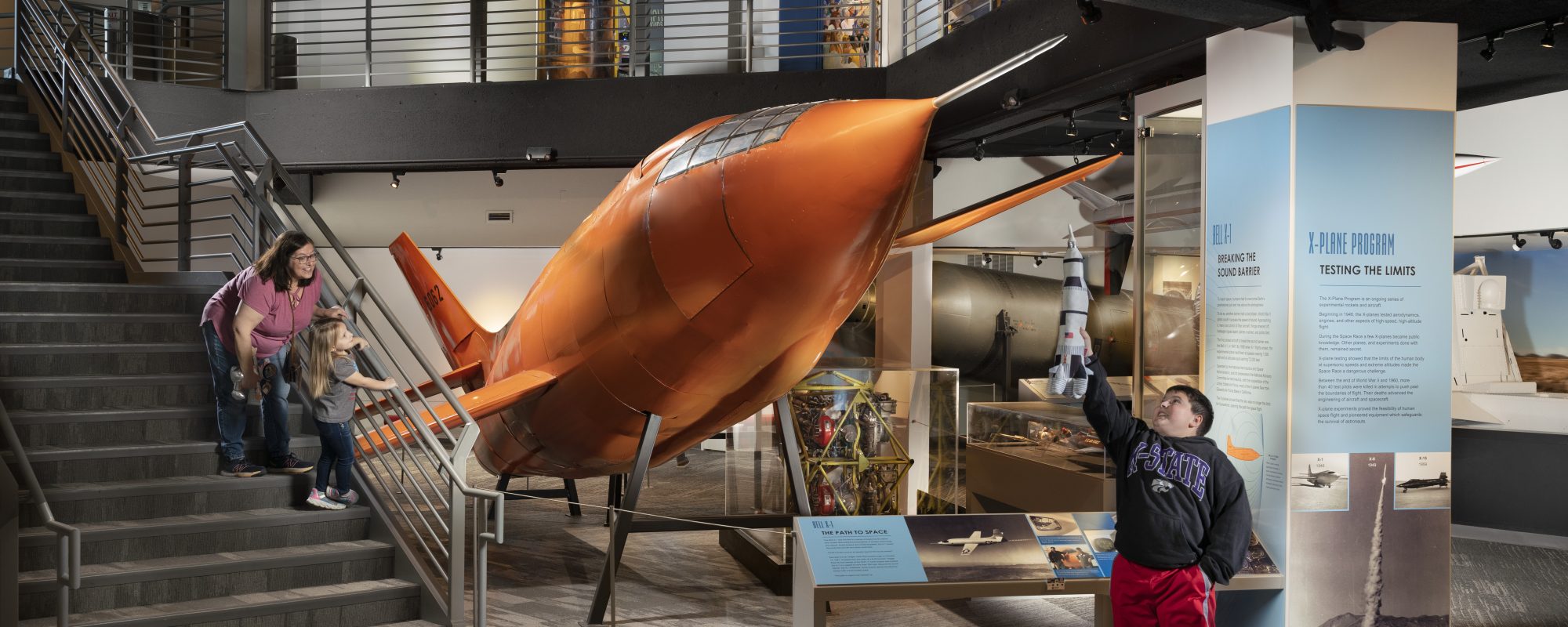The Cosmosphere will highlight amazing women who impacted the history of space and STEM fields throughout the month of March with a blog and daily social posts.
Table of Contents:
Pearl Young
Kitty O’Brien Joyner
Dorothy Johnson Vaughan
Mary Winston Jackson
Katherine Johnson
Annie Easley
Mary Golda Ross
Valentina Tereshkova
Henrietta Swan Leavitt, Annie Jump Cannon, Williamina Paton Stevens Fleming
One Hundred Years Ago…
In 1922, Pearl Young became the first female professional hired by the National Advisory Committee on Aeronautics (NACA), the government agency that preceded NASA.
When she identified problems with how the agency wrote and produced technical documents at breakneck speed, she designed and implemented a system of quality control for written materials that NACA implemented and NASA continues to use today. This sometimes put her at odds with the men around her.
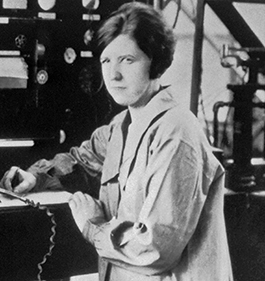
In describing Young’s legacy, NASA reports:
“The procedures established by Young often frustrated NACA engineers, who wanted to see their work disseminated promptly, as well as industry or military clients who wanted prompt answers to aeronautical problems. However, she successfully argued that the quality of the final product was more important than the speed with which it appeared.”
Determined To Get an Education
In order to attend high school, Young had to leave her home in rural North Dakota at 11 years old to work as a domestic. She eventually went on to graduate University of North Dakota with a triple major, earning degrees in physics, chemistry, and mathematics.
Emphasizing Work Done Well
NACA hired Young as a physicist in the Instrument Research Division. From there, she worked her way up to the Chief Technical Editor of NASA. She held that position for almost 20 years, revolutionizing the creation and disbursement of technical manuals and papers. According to NASA, in her vital role, she made sure that reports were “checked and rechecked for consistency, logical analysis, and absolute accuracy.”
An Eye, and a Heart, for Improvements
Born in 1895, Pearl Young passed away in 1968. She never married or had any children. NASA concludes an account of her astounding career and legacy (which includes a ride on the Hindenburg’s first west-east flight, and extensive work as an aeronautical history scholar), with a touching story about one more way Young strengthened and improved an important process in the world around her:
“In her later years she did not drive a car, and frequently used city buses and waited at bus stops….in her will, she left the City of Hampton [Virginia] approximately $15,000 to be used for the construction of benches and shelters at bus stops throughout the city.”
_____
She Had to Sue To Become A “First”
A determined Kitty O’Brien Joyner was the first woman graduate of the University of Virginia engineering program in 1937–after having sued the university so she could enter the all-male engineering school.
Then She Became Another “First”
In 1939 Joyner was the first female engineer at Langley Research Center–the research center was established by the National Advisory Committee for Aeronautics (NACA), which later became NASA in 1958. With a focus on electrical engineering, her work included wind tunnel control and research in supersonic flight, and she rose to the level of branch management during her career at NASA. She retired from NASA in 1971. Born in 1916, she died in 1993.
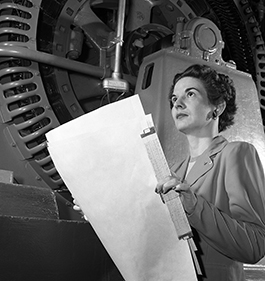
Her Affiliations Reveal Her Loyalties
Joyner was a member of the Institute of Electrical and Electronics Engineers, along with the Engineers Club in Virginia. Beyond her professional activities, she had been a member of the P.E.O. Sisterhood, Daughters of the American Colonists, United Daughters of the Confederacy, and she served as a chapter regent and organizer for the Daughters of the American Revolution.
_______
A Math Whiz From Kansas City
Dorothy Johnson Vaughan, originally from Kansas City, MO, left a job as a high school math teacher to work for NACA in the segregated “West Area Computing” unit at Langley Memorial Aeronautical Laboratory in 1943.
“In an era when NASA [has been] led by an African American man (retired Administrator Charles Bolden)…and when recent NASA Center Directors come from a variety of backgrounds, it’s easy to overlook the people who paved the way for the agency’s current robust and diverse workforce and leadership. Those who speak of NASA’s pioneers rarely mention the name Dorothy Vaughan, but as the head of the National Advisory Committee for Aeronautics’ (NACA’s) segregated West Area Computing Unit from 1949 until 1958, Vaughan was both a respected mathematician and NASA’s first African-American manager.” —from NASA’s Dorothy Vaughan biography
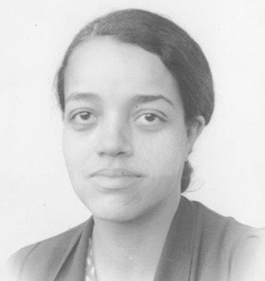
At the time Vaughan was hired, two years after President Roosevelt signed an executive order prohibiting racial, religious and ethnic discrimination in the defense industry, the Laboratory had just begun hiring Black women to process the mountains of aeronautical research data the laboratory produced.
After Five Years, a Promotion
The first two section heads for the West Computers, as the group in which Vaughan worked became known, were white women. Vaughan became NACA’s first Black supervisor in 1948, when she was promoted to lead the group.
A Storied Career
During her 28-year career with NACA/NASA, Vaughan worked on the mathematics of the SCOUT Launch Vehicle Program which focused on satellite launches. She learned FORTRAN coding language to become an expert working with electronic computers when NASA began using them.
The 2016 book Hidden Figures: The American Dream and the Untold Story of the Black Women Mathematicians Who Helped Win the Space Race, by Margot Lee Shetterly, and the film inspired by the book, finally brought national attention to the contributions of Vaughan and others of her fellow “West Computers.”
Born in 1910, Vaughan passed away in 2008.
_______
A Pioneering Engineer
“Sometimes they are not aware of the number of black scientists, and don’t even know of the career opportunities until it is too late.”
That’s NASA’s first Black female engineer, Mary Winston Jackson, describing what motivated her in the 1970s to help kids at the King Street Community Center in Hampton, Virginia. She helped them build a wind tunnel to conduct their own science and engineering experiments.
Jackson was no stranger to wind tunnels. In fact, a supersonic wind tunnel helped launch her own career!
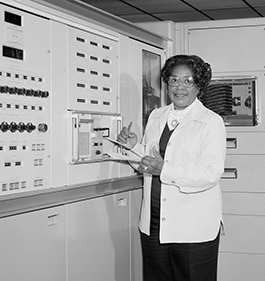
In 1953, Jackson received an offer to work on aeronautics experiments conducted in Langley laboratory’s 60,000 horsepower wind tunnel, which blasted air at speeds approaching twice the speed of sound. Before then, she had worked under Dorothy Vaughan at Langley for two years, as a mathematician in the segregated West Area Computing unit.
A Five-Year Journey to Become a “First”
When she moved over to working with the Supersonic Pressure Tunnel, as the powerful experimental wind tunnel was known, NASA reports that she received key mentoring, while still needing to fight uphill battles due to racial discrimination:
“Her supervisor … suggested she enter a training program that would allow Jackson to earn a promotion from mathematician to engineer. Because the classes were held at then-segregated Hampton High School, Jackson needed special permission to join her white peers in the classroom. Jackson completed the courses, earned the promotion, and in 1958 became NASA’s first Black female engineer.”
Her Legacy Continues
Born in 1921, Jackson worked for NACA/NASA for 34 years. She died in 2005. The Hidden Figures book and film chronicle her early career. In 2020, NASA renamed its Washington, D.C. headquarters the Mary W. Jackson NASA Headquarters building in her honor.
_______
She Lived to 101—and Received a Prestigious Award at 97
“She was told that women didn’t participate in the briefings or attend meetings; she asked if there were a law against it. The answer, of course, was no, and so [she] began to attend briefings.”
This is one of the fond remembrances of Katherine Johnson’s early years at Langley Research Center in her memorial profile posted online by NASA last year.
The world got to know Katherine Johnson’s story a little better in 2016 through the book and movie Hidden Figures. Her work in mathematics was critical to the first U.S. manned space flights.

Johnson worked at NASA Langley Research Center beginning in 1953. She worked under fellow mathematician, Dorothy Vaughan, in the West Area Computing unit.
Her Projects Changed History
As she advanced at Langley, Johnson was involved on a number of projects that changed the course of history, such as:
- Trajectory analysis for Alan Shepard’s May 1961 mission Freedom 7, America’s first human spaceflight.
- A report with the precise equations for orbital spaceflight with the landing position of the spacecraft specified
She is best known for her work on John Glenn’s Friendship 7 launch – in fact, Glenn asked for her to double check the electronic computer’s figures before the launch!
Before she retired from 33 years in research mathematics at Langley, Johnson would go on to:
- Create calculations that helped sync Project Apollo’s Lunar Module with the lunar-orbiting Command and Service Module.
- Work on Space Shuttle and Earth Resources Technology Satellite (ERTS, later renamed Landsat) missions.
- Author or coauthor 26 research reports.
Honored Late in Life
At 97 years old, Johnson was awarded the Presidential Medal of Freedom. In February 2021, Northrop Grumman named its Cygnus NG-15 spacecraft, used to supply the International Space Station, the SS Katherine Johnson in her honor.
Johnson enjoyed speaking to students about her work, and hoped to encourage others to pursue STEM careers, saying “We will always have STEM with us. Some things will drop out of the public eye and will go away, but there will always be science, engineering and technology. And there will always, always be mathematics. Everything is physics and math.”
Born in 1918, she died in 2020 at 101 years old.
_______
Adapt, and Keep Adapting
Annie Easley discovered her career in 1955 through an article on the “human computers” at the NACA (National Advisory Committee for Aeronautics) Aircraft Engine Research Lab in Ohio (which would later become the NASA Glenn Research Center). Within weeks, she was working as a “human computer” calculating and performing complex simulations. One of the first African-American employees, she faced discrimination—according to one interview, she said, “My head is not in the sand. But my thing is, if I can’t work with you, I will work around you. I was not about to be [so] discouraged that I’d walk away. That may be a solution for some people, but it’s not mine.”
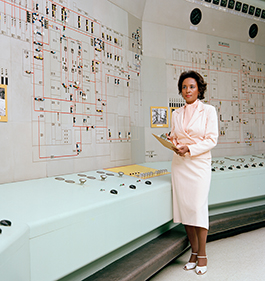
As technology changed, she adapted to computer programming and code development and implementation. Her work was used for programming a range of machines, including hybrid vehicles and the Centaur upper-stage rocket.
In the 1970s, Easley returned to school to pursue a mathematics degree from Cleveland State –while also working full time. She actively encouraged female and minority students in the STEM fields as a speaker, and in her later career, worked as an Equal Employment Opportunity counselor.
A NASA biography of Easley portrays a woman full of vitality, who founded a ski club and helped put on an annual children’s Christmas play, among other activities outside of work. Her remarkably vivid memories of her early years working for the government as a professional woman in the 1950s are captured in this NASA oral history, recorded in 2001.
Easley retired in 1989 after 34 years with NASA.
Born in 1933, she died in 2011.
_____
She Helped Make Space Travel Possible in Her Time
When Mary Golda Ross joined the secretive Lockheed Skunk Works division as one of forty founding engineers in 1952, she was the only woman on the team besides the secretary. Skunk Works is now known for producing the SR-71 Blackbird high-altitude spy jet and the F-117 Nighthawk stealth plane, among other achievements. Ross herself worked on early space projects, including satellites and missiles and the Agena rocket used for Gemini rendezvous and docking trials.

She Imagined Traveling Farther
Prior to joining Skunk Works, Ross had worked at Lockheed for 11 years, starting as a mathematician in 1941. She would go on to author several significant documents in her field, and she was a co-author of the NASA Planetary Flight Handbook Vol. III, which theorized about space travel to Mars and Venus.
Pride in Her Heritage Led to a Generous Gift
Ross was a member of the Cherokee nation. As the first known Native American woman engineer, she is memorialized on a special edition of the Sacajawea dollar coin.
Ross was born in 1908 and raised in the Cherokee community of Park Hill, Oklahoma. Her contributions extend beyond her legacy in aerospace engineering to philanthropy. Ross gave a $400,000 bequest to the Smithsonian’s National Museum of the American Indian on her death in 2008.
She’d attended the museum’s grand opening four years earlier, at age 96. At the time, she commented that the museum’s significance was in telling “the true story of the Indian, not just the story of the past, but an ongoing story.”
Through her works and gifts, her life became part of the ongoing story of the exploration of space.
Mary Golda Ross image courtesy of Northeastern State University Special Collections and Archives.
_______
First Woman in Space
Valentina Tereshkova is the first woman to have flown in space. Her logic? “If women can be railroad workers in Russia, why can’t they fly in space?”
Unlike most Astronaut and Cosmonaut trainees, Tereshkova had no pilot experience. Instead, she had parachute experience—126 jumps! This would come in handy for her space mission: although U.S. Astronauts made water landings, Soviet Cosmonauts parachuted from their capsules to end their missions on the ground.
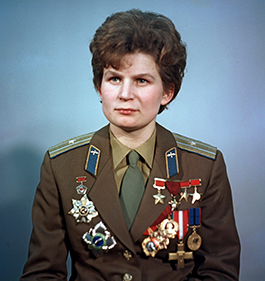
When Tereshkova launched into space on the Vostok 6 capsule, one of her countrymen had already been in orbit for two days on the Vostok 5. The two spacecraft actually came within 5 kilometers (3.1 miles) of each other during her flight!
An Active Life Back on Earth
Tereshkova has received a number of awards including the Order of Lenin, the Gold Star Medal, and the United Nations Gold Medal of Peace. She married Cosmonaut Adriyan Nikolayev and had a daughter, Elena—the first child born to parents who had been to space! She has also been involved in politics, holding multiple positions including being a member of the Supreme Soviet Presidium and deputy chair of Yaroslavl province, her home region.
After 80+ Years, She Still Wants To Talk About Space
Tereshkova celebrated her 85th birthday this month, on March 6.
“I think it’s tremendously important to meet people, to establish a connection and tell people about space,” she said in an interview with The Guardian. “It can increase trust, and that is something that is so badly needed, today.”
_____
The Women of Silent Sky
Contemporary American playwright Lauren Gunderson wrote Silent Sky to be about “the glory and hard work of science.” It’s also about the bonds between women united in a common cause. It focuses on three women who worked in astronomy beginning in the 1800s.
Did you know?
Henrietta Swan Leavitt (1868-1921) had the epiphany that certain types of stars called Cepheid variables could be used as benchmarks to measure galactic and intergalactic distances. Leavitt discovered a proportional relationship between these stars’ luminosity and the time it takes each one to complete a pulsation cycle. This law of nature that she discovered became one of the principles Edwin Hubble applied for his own breakthrough, when he established that the universe is expanding.
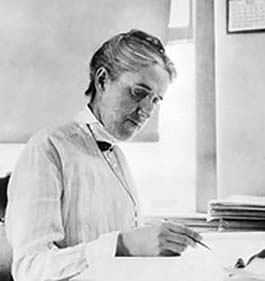
Annie Jump Cannon (1863-1941) learned a love of astronomy from her own mother, who taught her to identify stars seen from their attic. Her work as an astronomer is foundational to stellar classification systems used today. She created the Harvard Classification Scheme, the first system to organize stars based on their temperature.
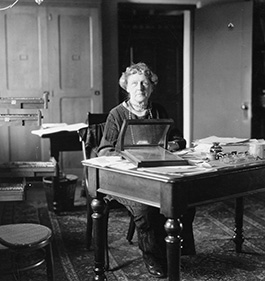
Williamina Paton Stevens Fleming (1857-1911) in 1888 discovered the Horsehead Nebula, made famous in recent decades by Hubble Space Telescope photographs. Her path to a career in astronomy began when she was hired as a maid in the home of Edward Charles Pickering, director of the Harvard College Observatory. His wife recognized Fleming’s talents and intelligence and recommended her for a position at the observatory.
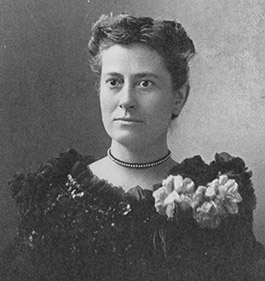
All three women worked as “computers,” applying mathematics to study and classify data from the study of photos of stars taken at the Harvard College Observatory.
_____
Actually, It Is Rocket Science. Feminism, Too.
A NASA “First.” At Times, an “Only.”
One thing Frances “Poppy” Northcutt knew from a young age was that she did not want to be in a stereotypical female role, like a nurse, teacher, or secretary. She went into a mathematics field because it was male dominated. For her, that signaled better pay and more opportunities.
Northcutt graduated from University of Texas at Austin with a degree in mathematics and started as a contractor for TRW Systems (now a part of Northrop Grumman) working for NASA in 1965 as a human “computress.”

“What a weird title this is,” she recalled thinking then, in an interview with TIME magazine in 2019. “Not only do they think I’m a computer, but they think I’m a gendered computer.”
She was promoted a year later to a Return-to-Earth Specialist, calculating mission trajectories, making her the first woman in a technical position at Johnson Space Center, Houston, TX.
Poppy was the only woman working in NASA’s Mission Control during the Apollo 8 mission. (Her work involved Trans-Earth Injection.)
A Committed Professional, A Full-Time Feminist
She went on to be involved with Apollo 10, 11, 12, and 13—where Northcutt’s team troubleshot the Apollo 13 oxygen tank explosion emergency. After concluding her work at NASA, she held a position in the Houston mayoral office as a women’s advocate. Following that, her career focus shifted to the law. She worked as an engineer while obtaining her law degree.
Serving as the first prosecutor in the domestic violence unit of the district attorney’s office in her county and moving into private practice, Northcutt had a career focused on women’s rights. She was an advocate for the Texas Equal Rights Amendment, passed in 1972.
How did her work in space missions help her law career? According to an interview with Space.com, she was accustomed to “evaluating the reasonableness of technical evidence.” A continuing advocate, she describes herself on social media as: “One time rocket scientist, sometime lawyer, full time feminist.”
Now Imagine This Young Blonde, the Only Woman in Mission Control…
Wait! You don’t have to imagine! Priceless footage of Poppy, including an interview showing off her poise and smarts, and context describing her importance to the Apollo program, appears in episode 2 of the 2019 PBS series Chasing the Moon. Watch it here.
_____
She Wrote Famously Error-Free Code
Software engineer Margaret Hamilton is pictured here next to a physical copy of the Apollo navigation software. Hamilton led the Massachusetts Institute of Technology (MIT) team that wrote the software for the Apollo Guidance Computer, the brains behind the Command Module (CM) and Lunar Module (LM).
Hamilton and her team from MIT started from square one to build the critical pieces of the software needed to land astronauts on the Moon. At the time they were writing the software for the Apollo program, computer science and software engineering weren’t established fields.
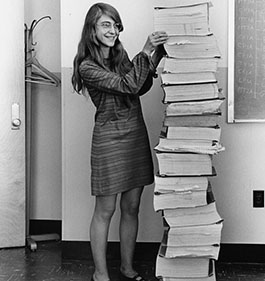
A 1976 historical monograph from the Charles Stark Draper Laboratory notes that the code for the Apollo Guidance Computer “had to be as near error-free as possible and any anomalies had to be understood and recorded for possible affect (sic) on the mission. Actually, no program errors were ever uncovered during the [Apollo] missions.”
This error-free code worked flawlessly for every Apollo mission. During Apollo 11, the LM’s computer was overwhelmed with data, but still performed as it was supposed to. A switch had inadvertently been put into the wrong position, which led to the 1201 and 1202 alarms that Neil and Buzz saw during their descent to the lunar surface. The computer couldn’t keep up, so it prioritized higher importance calculations.
The team that Hamilton led helped land men on the Moon before the end of the 1960s, fulfilling Kennedy’s challenge and cementing her place in computing history. In 2016 President Obama awarded Margaret Hamilton the Presidential Medal of Freedom, our Nation’s highest civilian honor.
_____
She Wanted To Create the Data, Not Process It
Dr. Christine Darden had a forty-year career with. In 1967, she started out as a “human computer” at NASA’s Langley Research Center, but she wanted to create the data, not process it.
Her page at NASA History recounts the self-advocacy she had to assert to fully utilize her knowledge and skills:
“After wading through daily calculations for eight years, Darden approached her supervisor to ask why men, with the same educational background as her (a master of science in applied mathematics), were being hired as engineers. Impressed by her skills, her supervisor transferred her to the engineering section, where she was one of few female aerospace engineers at NASA Langley during that time.”
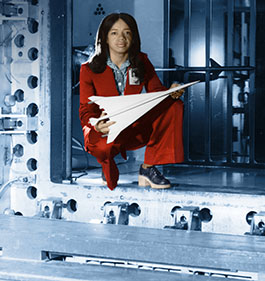
Eventually considered an expert in supersonic flight and sonic booms, Darden worked in mathematics, data analytics, and aeronautical engineering. She went on to earn her doctorate in mechanical engineering in 1983.
Darden retired from NASA as director of the Office of Strategic Communication and Education in March 2007.
Among many honors, she received the Certificate for Outstanding Performance from NASA – 10 times! She was also named Black Engineer of the Year by US Black Engineer & IT magazine. In 2019, Darden received the Congressional Gold Medal.
_____
Her Career Has Epic Highs and Historic (Deep-Sea) Lows
Dr. Kathryn Sullivan graduated from the University of California, Santa Cruz with a degree in Earth science and obtained a doctorate in geology from Dalhousie University.
She was selected as an astronaut candidate in 1978 and is a veteran of three spaceflights. In 1984, as part of the STS-41G mission, she became the first U.S. woman to perform an EVA (Extravehicular Activity).
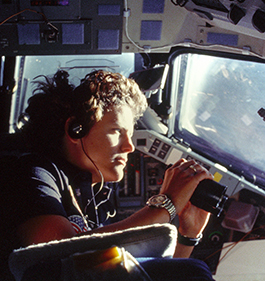
She held several positions in the Shuttle program until 1993, when she left NASA to pursue a Presidential appointment as Chief Scientist at the National Oceanic and Atmospheric Administration (NOAA). Her career included President and CEO of COSI, Director of the Battelle Center for Mathematics and Science Education Policy in the John Glenn School of Public Affairs at The Ohio State University, and Under Secretary of Commerce for Oceans and Atmosphere, among others. She had a significant role in NOAA work in the realm of weather, water, and climate science and the collection of environmental intelligence.
With a wide-ranging career, Dr. Sullivan was a 2004 inductee to the Astronaut Hall of Fame. She’s held positions on the National Science Board, National Commission on Space, and the Pew Oceans Commission as well as holding the position of Chair of the Ohio Aerospace and Defense Advisory Council, Adjunct Professor of Geology at Ohio State University, Fellow of the American Association for the Advancement of Science and the American Institute of Astronautics and Aeronautics.
Dr. Sullivan recounts being part of the team that launched, rescued, repaired, and maintained the Hubble Space Telescope in her 2019 book Handprints on Hubble: An Astronaut’s Story of Invention. She describes herself today as “scientist, astronaut, explorer.” One of her more recent adventures was visiting the deepest part of the oceans in a specially designed submersible. Once there, she placed a phone call from 35,853 feet below sea level…up to the astronauts on the International Space Station!
Learn more about what this inspiring woman is up to these days at kathysullivanastronaut.com.
_____
She Flew Into History
“I never told anybody I wanted to be an astronaut or pilot,” Eileen Collins said, recalling her childhood in the 1960s and her college years in the 1970s. “I consciously never talked about it because I knew people would say, ‘You can’t do that.’ And I didn’t want to hear it. I just didn’t want to fight it – it wasn’t worth it. Even when I started my flying lessons – and this would have been when I was between my junior and senior year in college – I didn’t tell my friends. I don’t think I even told my parents.”
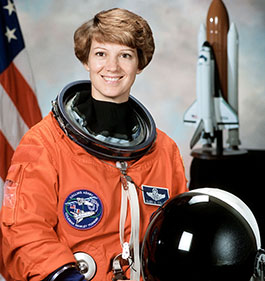
Eileen Collins was born in Elmira, New York in 1956. When she was young, she found her inspiration in the Mercury astronauts, in the daring of Amelia Earhart, and in the stories of the Women Airforce Service Pilots of World War II. She received an associate’s in mathematics/science from Corning Community College and went on to achieve a bachelor’s in mathematics and economics from Syracuse University. After that, she earned her master’s in operations research at Stanford and a master’s in space systems management from Webster University.
She attended Vance Air Force Base where she was one of four women chosen for the Undergraduate Pilot Training. There, she earned her pilot wings and became a T-38 Talon instructor pilot and eventually a C-141 Starlifter pilot.
Collins attended the U.S. Air Force Academy from 1986-1989, where she became the second female pilot to attend the U.S. Air Force Test Pilot School. After being selected as an astronaut in 1990, she became the first female commander of a space shuttle on STS-93 in 1999, which deployed the Chandra X-Ray Observatory.
An Important Mission, an Impressive Career
Collins also piloted the historic “Return to Flight” mission, STS-114, to the International Space Station (ISS), following the space shuttle Columbia disaster. During this mission she became the first astronaut to complete the 360-degree pitch maneuver. This maneuver allowed astronauts on the ISS to take photographs of the shuttle’s underbelly to safeguard that there was no threat of debris damage to the shuttle during reentry into the Earth’s atmosphere.
All totaled, Collins logged over 6,751 hours in 30 different types of aircraft. She retired from the Air Force in 2005 and retired from NASA in 2006.
She Had a Specialty They Needed
Her advice for young people is to “go into the field you are most interested in. If you love your job, you’ll do well in your job.” Collins discourages people from choosing what to study by looking at what other Astronauts specialize in. The exact opposite worked for her. When she joined the corps, there were no Astronauts in her field—operations research. “I said, ‘I think I can fill a void,’ and I think they bought it.’”
In 2021, Collins published her long-awaited memoir: Through the Glass Ceiling to the Stars: The Story of the First American Woman to Command a Space Mission.
_____
Space Flight Is One of Her Many Achievements
Dr. Mae Jemison received her Bachelor of Science in chemical engineering from Stanford as well as an M.D. from Cornell. With a focus in both medical research and engineering, her work ranged from computer programming to research on the Hepatitis B vaccine to General Practice to Area Peace Corp Medical Officer for Sierra Leone and Liberia in West Africa.
She was accepted to the Astronaut program in 1987. Dr. Jemison flew on the STS-47 Skylab-J Mission and worked as co-investigator of a bone cell experiment onboard. She was the first woman of color in space.
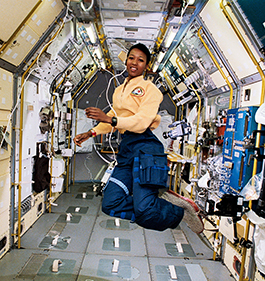
After her time with NASA, she founded the Jemison Group, a technology consulting firm with a focus on socio-cultural issues. Through her foundation, The Dorothy Jemison Foundation for Excellence, she runs 100 Year Starship, which aims to keep space exploration “audacious and inclusive.” She has authored several books, and she’s the first astronaut to have an appearance on Star Trek!
“Don’t let anyone rob you of your imagination, your creativity, or your curiosity. It’s your place in the world; it’s your life. Go on and do all you can with it and make it the life you want to live.”
– Dr. Mae Jemison
_____
First American Woman in Space Inspired Many
Sally Ride was an astronaut, physicist, engineer and educator. When Ride applied to the astronaut program, there were 8,000 applicants. Thirty-five were chosen. Six were women. In 1983, she became the first American woman in space–the third woman after Soviet cosmonauts Valentina Tereshkova and Svetlana Savitskaya.
On the historic STS-7 mission, Ride operated a robotic arm that helped put two communications satellites in space.
Ride’s time with NASA lasted four more years and included flying on one additional shuttle mission in 1984.
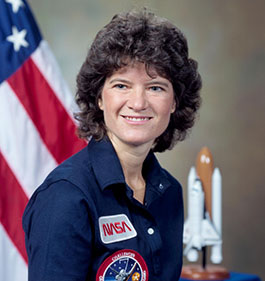
A Role Model in Space and on Earth
Post-NASA, Ride became a professor of physics, served on committees that studied the Challenger and Columbia space shuttle disasters, and received many honors including the Von Braun Award, induction into the National Women’s Hall of Fame, and the NASA Space Flight Medal–Twice!
Connecting youth to science and mathematics was a long-time passion of hers. She founded a NASA project that allowed middle schoolers to use a camera on the International Space Station to take pictures of Earth for their research and studies. She wrote science books for students and teachers, and she appeared at science programs and festivals around the country.
Born in 1951, Sally Ride died in 2012 at the age of 61. Former NASA Deputy Administrator Lori Garver describes Ride’s sweeping impact:
“Sally was a personal and professional role model to me and thousands of women around the world. Her spirit and determination will continue to be an inspiration for women everywhere.”
_____
She Traveled Far To Pursue Her Dream
Kalpana Chawla was born in Karnal, India. She was the first Indian-born woman in space. She immigrated to the U.S. in the 1980s after receiving her bachelor of science degree in aeronautical engineering from Punjab Engineering College in India.
She went on to earn two more degrees in this field: a master’s from the University of Texas and a Ph.D. from the University of Colorado.
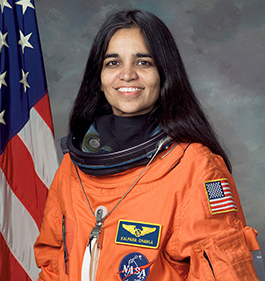
In 1988, she started work with Ames Research Center with NASA in power-lift computational fluid dynamics. NASA selected her as an Astronaut candidate in 1994. Her first flight was in 1997 on STS-87. She held a number of roles including mission specialist, prime robotic arm operator, crew representative for shuttle and station flight crew equipment, and lead for Astronaut Office’s Crew Systems and Habitability section. She logged over 30 days in space.
In 2003, she flew on the Columbia shuttle again on mission STS-107. The crew on this science and research mission worked 24 hours a day in two alternating shifts to complete 80 separate experiments. Tragically, this mission ended in the loss of the crew when the shuttle broke apart during re-entry on February 1, 2003. Chawla’s dreams of space live on in the young lives she inspired. Her contribution to research on the International Space Station helped humankind understand more about life in space, and her work as a research scientist in aerodynamic optimization is documented in a number of technical conference papers and journals.
In a 2020 National Geographic docu-series that features his daughter, Chawla’s father remembers excitement about flight was present from her earliest years:
“Kalpana was about three or four years old when she first saw a plane. She had been playing on the rooftop when she saw a plane flying above our house. She seemed so excited. I took her to the flying club near our house where a pilot agreed to take us for a ride. Kalpana’s joys knew no bounds. She had always wanted to fly.”
_____
A Natural Math-Lover, Guided by Devotion to God, Education, and Service
Dr. Tahani Amer grew up in Cairo, Egypt in the 1970s and 80s. She immigrated to the United States at the age of 17 when she married. She had an interest in math, and got an A in her first calculus class even though she did not speak any English. Her goal was to be an engineer. Amer attributes her interest to watching her father working on his car’s engine as a child.
Amer received an associate’s degree while taking care of her two children. She re-entered school to receive her Bachelor’s in Mechanical Engineering and started working at NASA during her senior year of college.
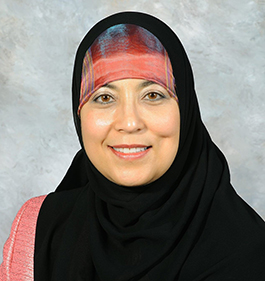
“I started working at NASA on the Computational Fluid Dynamics (CFD) project. By working on this project, I gained valuable experience and fulfilled my dream to work with scientists and researchers solving real-life problems!”
Amer went on to receive a Master’s in Aerospace Engineering and a Doctorate in Engineering.
Her research at NASA also included work in one of NASA’s wind tunnels to conduct pressure and thermal sensitive paint experiments for NASA’s Aeronautic Research efforts. She created and patented a way to measure the thermal conductivity of a thin film, which was an innovative addition to thermal modeling.
Currently Dr. Amer works as a Program Executive at NASA. Amer was recognized for her contributions to science in 2022 with the Award for Science from the U.S. Council of Muslim Organizations.
On her Women@NASA page, Dr. Amer introduces herself by describing the values that guide her life:
“I am an American Muslim NASA employee who grew up in a suburb of Cairo, Egypt. I have always strived to live by three simple principles: Please God and you will please all. Education is the key to opportunity. Serve others with compassion and kindness.”
_____
Impacts Within and Beyond NASA
Dr. Ellen Ochoa began her career in research engineering at Sandia National Laboratories and NASA’s Ames Research Center. She earned her bachelor’s degree in physics from San Diego State University and went on to earn a master’s and Ph.D. in electrical engineering from Stanford.
Ochoa became an Astronaut in 1990 and became the first Hispanic woman to go to space in 1993 aboard the space shuttle Discovery. She’s had over 1,000 hours in space!

She was awarded NASA’s Distinguished Service Medal, the organization’s highest award, in 2015. She was also the first Hispanic director of NASA’s Johnson Space Center (2013-2018)– the second female director. In 2018 she was inducted into the International Air and Space Hall of Fame. Ochoa was a member of the National Science Board from 2016–2022. She chaired the board from 2020-2022 and previously served as its vice chair.
Maybe you’ve seen her name around? She’s had six schools named after her! A fitting tribute for someone who emphasizes the importance of learning and has given more than 300 presentations on the importance of STEM education.
_____
What Does She Do When She Doesn’t Sleep?
JUST ONE THING.
Dr. Sabrina González Pasterski has been hailed as the “Next Einstein.” She is a theoretical physicist who studies high energy physics. She describes herself as, “a proud first-generation Cuban-American and Chicago Public Schools alumna.”
At age 12, Pasterski began building an airplane that she eventually flew at 16. She garnered a number of achievements and awards in her teenage years including an internship with NASA and the Lindau Nobel Young Researcher title. She graduated first in her class as an undergraduate at MIT. Her GPA? 5.0.

She went on to earn a Ph.D. in physics from Harvard University in 2019. Then went on to recieve her Postdoc from Princeton University in 2021.
At the Princeton Center for Theoretical Sciences, Pasterski founded, and continues to run, the Celestial Holography series of workshops on recent advancements in flat space holography. She currently works as a physics professor with the Perimeter Institute, a Canadian organization focused on theoretical physics.
Pasterski describes her devotion to physics this way:
“When you’re tired you sleep, and when you’re not, you do physics.”
Learn more about Pasterski’s work on her PhysicsGirl YouTube channel.
_____
Concern for People and Planet Took Her From Tech to Law
Stephanie Castillo founded “Latina Girls Code” in 2014. It targeted Latinas between seven and 17, with a focus on tech languages and hands-on education to disadvantaged children. The program ran one-day “hackathons” along with six- and 12-week workshops teaching girls programming and entrepreneurship skills.
Although the program began with a focus on making coding more accessible to communities where it had not been available, Castillo soon found that girls in her programs needed support in other areas, too.
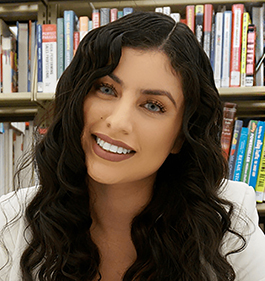
“It’s more than just a technological transformation for our communities that have been locked out of this resource,” Castillo said in an interview with Hispanic Network magazine. “What we’re seeing is our students are facing unique experiences, unique circumstances.”
So Castillo also worked as an immigration adviser for the girls in her programs, helping to file permits under the Deferred Action for Childhood Arrivals program. This interest moved her into the fields of criminal law, juvenile justice, disability rights, and international human rights. She has conducted research in a variety of countries and has worked in collaboration with United Nations Representatives.
Castillo is now studying law at Northwestern University and intends to focus on environmental law.
_____
She Was the Last Line of Defense Against Complacency
Born in 1957, Marta Bohn-Meyer began her work in aerospace as a student at Rensselaer Polytechnic Institute in New York in the late 1970s. For three years, she participated in a cooperative research and education program the school held at NASA’s Langley Research Center in Hampton, Virginia.
She Moved up Through the Engineering Ranks
When she finished school, she joined NASA’s Armstrong Flight Research Center (then Dryden) as an aeronautical research and operations engineer. She would eventually rise to the post of chief engineer after 22 years at this same location, after a series of roles with increasing responsibility, including:
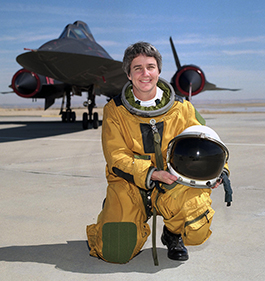
- Project manager for the F-16 XL Supersonic Laminar Flow Control
- Deputy director of aerospace projects
- Director of safety and mission assurance
- Director of flight operations
Her Work Included a Notable “First”
In 1991, Bohn-Meyer became the first woman to crew the triple-sonic SR-71 Blackbird. She was assigned as a NASA flight engineer and had been with NASA twelve years by then. Her role was to help NASA obtain high-speed, high-altitude data to improve future aircraft design. The only other woman to have flown in the famously fast plane was a congresswoman who rode as a VIP guest in 1985.
Remembered with Admiration
Widely known as a precision aerobatic pilot, Bohn-Meyer died Sept. 18, 2005, when the Giles G-300 she flew in an aerobatic practice routine crashed near Oklahoma City.
Retired NASA deputy administrator Fred Gregory recalls being first assigned to mentor her when she began at Langley as a student:
“She was smart, detail-oriented, opinionated and professional well beyond her age.”
Kevin Petersen, director for Dryden (now Armstrong) Flight Research Center at the time of her passing, remarked on Bohn-Meyer’s “strength and her commitment to all she pursued.”
“We committed lives to this person’s judgment every day; she was the last line of defense against complacency. And she never let me—or Dryden—down.”
_____
Small Town Girl Breaks a Big Record
Shout-out to the Midwest! Peggy Whitson, born in 1960, is from Mount Ayr, Iowa. When she grew up, the town had less than 2,000 residents. Whitson holds a Bachelor’s degree in Biology and Chemistry and received her Doctorate in Biochemistry in 1985. She worked in biochemistry research for NASA for seven years before entering the astronaut training program in 1996.
In 2002, she completed her first of three long-duration missions to the International Space Station. Her longest mission was 289 days, 5 hours and 1 minute.
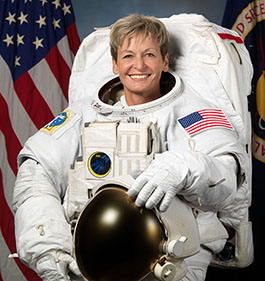
Another Record, and a Female First
Between all of her missions, Whitson has accumulated 675 days in space. Her third and final mission with NASA concluded on September 3, 2017. Nine Cosmonauts have exceeded Whitson’s cumulative time in space, but her total still stands as the record for an American.
Whitson has performed the most spacewalks of any woman (10!). Her awards and recognition range from the Iowa Aviation Hall of Fame, to the NASA Silver Snoopy, to the Russian medal of Merit for Space.
Whitson also worked as the Chief of the Astronaut Office at NASA. She was the first woman to serve in the position. She retired from NASA in 2018.
New Chapter, Back to Space
Following her retirement from NASA, Whitson joined Axiom Space as Director of Human Spaceflight. Whitson was the commander of Ax-2, the second private astronaut mission to the International Space Station. Ax-2 launched on May 21, 2023, and docked with the International Space Station for eight days. The private astronauts landed on May 31, 2023, bringing Whitson’s total time in space to 675 days. In addition to her many other records and milestones, Whitson is now the first woman to command a private space mission.
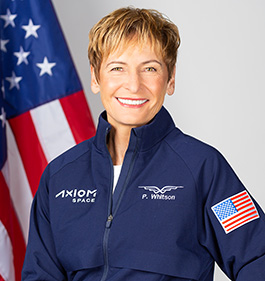
Note to Self
On her third and final NASA mission, Whitson wrote a letter to her nine-year-old self for the CBS News “Note to Self” series. It paints a picture of a woman who maintained tremendous determination in the face of setbacks:
“It will be 10 years of applying before ever becoming an astronaut. The rejections will be discouraging, but in your typical style you will just keep trying. All those years of anticipation will be surpassed when the solid rocket boosters ignite and you will literally roar into space.”
_____
Her Short Life Left a Towering Legacy
Rosalind Franklin, born in 1920, was an English chemist known for her work with x-ray crystallography. She is remembered for her x-ray diffraction images of DNA. Her image, Photo 51, is the image that led to the discovery of the double helix structure of DNA. While her work was only acknowledged posthumously, it was monumental to our understanding of DNA. Her other notable work included study of coal, viruses, and graphite.
She received a number of awards and recognitions after her death in 1958 at just 38 years old. In 2019, the European Space Agency named their new Mars ExoRover the Rosalind Franklin, in her honor.
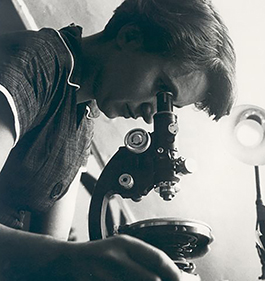
She Looked to the Skies With Excitement
“In the last year of Rosalind’s life, I remember visiting her in hospital on the day when she was excited by the news of the [Soviet Sputnik satellite] – the very beginning of space exploration,” Franklin’s sister, Jenifer Glynn, said according to the BBC. “She could never have imagined that over 60 years later there would be a rover sent to Mars bearing her name, but somehow that makes this project even more special.”
More on the Rosalind Franklin Rover
Although the Rosalind Franklin Mars ExoRover has already been built and tested, its planned 2022 launch has been delayed, according to the ESA. The Mars exploration mission it supports had been a joint program between the ESA and Roscosmos, the Russian space agency. But due to the 2022 Russian invasion of Ukraine, the partnership with Russia was formally terminated by ESA in July 2022. The mission is not scheduled to occur before 2028 due to the need for a new non-Russian landing platform.
_____
She’s the Nuts and Bolts Woman
Kathy Lueders learned the nitty-gritty logistics of the U.S. space program in her first job out of college at the NASA White Sands Test Facility, where she began her career thirty years ago.
There, she coordinated project logistics for the shuttle program, collaborated with contractors, and managed the White Sands depot. In an oral history interview for NASA, she recalls the importance of her time there:
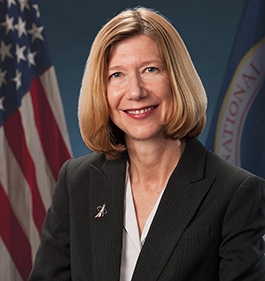
“I always view White Sands as like a project training ground, because they grow people there in these very dynamic project environments, and then you’ve gotten this great experience to run a project. Nuts and bolts, run budget, schedule, work with program offices, do this whole thing. I was, at that point, plucked to go and develop the post-production support contractors, which is really the contract for sustaining logistics support for the International Space Station.”
Operations Are the Core for Her of Her Mission
Today, she oversees the International Space Station, the Commercial LEO Development Program, Space Communications and Navigation (SCaN), Launch Services Program (LSP), Human Spaceflight Capabilities, and operations of crewed Artemis missions as Associate Administrator for the Space Operations Mission Directorate at NASA. Before her appointment to this position in 2021, she was named the first woman to oversee NASA’s human spaceflight program in 2020.
Lueder is happy to focus on the mission and launch side of the equation today. She thrives on solving the behind-the-scenes operations problems that make space missions successful. In a TechCrunch discussion about space, she noted:
“It’s the infrastructure pieces that people don’t talk about,” she replied. “You know, we’re gonna need power on the Moon. We’re going to need to be able to move cargo around on the Moon. We’re going to need to be able to have communication and additional relays on the Moon. We tend to not think of roads and power lines as sexy things. But this is infrastructure that, if you ever run a business, you need those kinds of things to be able to operate. Try to run a business without power — try to run a business without comms.”
_____
Strong Roots, Great Heights
Originally from South Carolina, Vanessa Wyche earned a Bachelor of Science in Engineering and Master of Science in Bioengineering from Clemson University. She worked for the U.S. Food and Drug Administration prior to joining NASA in 1989. Today, she is the first African American woman to lead any NASA center, serving as Director of Johnson Space Center.
“I’m humbled and honored to be chosen to lead the more than 10,000 employees at Johnson Space Center, who work each day to enhance scientific and technological knowledge via space exploration to benefit all of humankind,” Wyche said in a press release about her newest position.
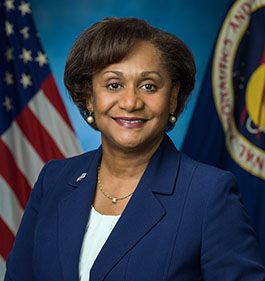
Although she worked her way to a top role in one of the world’s premier space agencies, Wyche’s connections to her alma mater remain strong. She serves as a member of Clemson University’s College of Engineering, Computing and Applied Sciences advisory board, and in 2019 she was inducted into the Thomas Green Clemson Academy of Engineers and Scientists in recognition of her contributions to the engineering profession.
_____
A Big Promotion After Fourteen Years
Janet Petro made history on June 30, 2021, when she became the first woman director of NASA’s John F. Kennedy Space Center in Florida. Before moving into that role, she spent fourteen years as Kennedy’s deputy director.
One of Petro’s duties as deputy director was to collaborate with other agencies, including the Federal Aviation Administration and U.S. Air Force, to streamline processes and support commercial space operations.
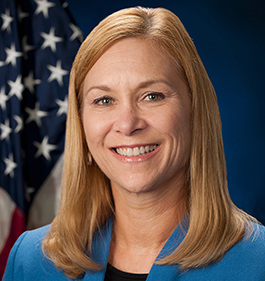
She Sees the Positives of Privatizing Spaceflight
Petro sees the commercialization of space as a positive for NASA and for the U.S. In an interview with Bostonia, she commented:
“We are taking advantage of the success of the space industry, starting with [taking] cargo to the International Space Station. If NASA owns and operates all the assets associated with that, you’re going to pay the price for being the sole customer of that one spacecraft. [Now], other users can use that, as well. So the government wouldn’t be the sole funder of that vehicle.”
Before She Was a NASA “First,” She Was a West Point “Second”
Petro graduated from the U.S. Military Academy at West Point in 1981, in only the second West Point class to include women. She began her professional life as a commissioned officer in the U.S. Army.
She holds a Bachelor of Science in engineering from West Point and a Master of Science in business administration from Boston University’s Metropolitan College.
_____
She Reached for the Stars (And Met a Few, Too)
Maggie Masetti is NASA’s social media lead and website manager for the James Webb Space Telescope (JWST). Her work at NASA began with a summer internship in 1996. She has great advice for young women who hope to work in astronomy-related fields:
“I didn’t get calculus in high school, which meant I had to learn it in a 300-person university lecture hall. It wasn’t easy. So for anyone looking at being a scientist or engineer … get as much math as you can as early as you can, while you are still in a small classroom environment. You might not realize when you are young (I didn’t!) that astronomy is all about math.”
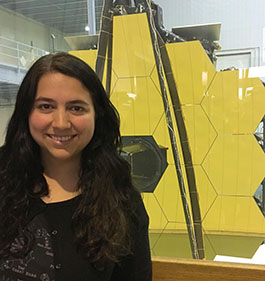
Masetti ultimately powered through the challenge of a large lecture class. She graduated from the Pennsylvania State University in 1997 with a BS in Physics and Astronomy/Astrophysics and a Math minor.
In her twenty-six years of education, public outreach, social media and website management for NASA, Masetti has connected with Bill Nye the Science Guy, Star Trek’s Robert Picardo and Jimmy Fallon. She’s visited the set of the CBS show “The Big Bang Theory,” and she’s spoken at AwesomeCon and SXSW, all to help spread the word and build excitement about James Webb Space Telescope and other NASA projects.
Masetti also organized and participated in a Reddit “Ask Me Anything” Q&A with American women working on JWST “about the female experience working on a NASA flagship mission.”
_____
She Was All About Stem–Before It Was Cool
To round out the end of Women’s History Month…of course we have to mention the Cosmosphere’s founder, Patty Carey!
Have you ever wondered why Hutchinson, Kansas, is the home of the Cosmosphere? It’s because of our wonderful founder, Patty Carey. Her desire to share the wonders of astronomy became the foundation for the Cosmosphere’s internationally recognized space artifact collection.
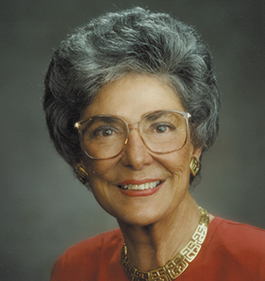
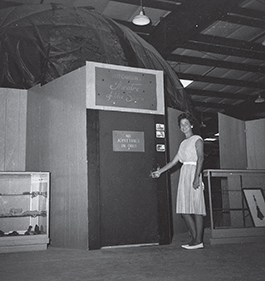
Fueled by her life-long interest in science, Patty established the first planetarium in the state of Kansas in 1962, called “Hutchinson’s Theatre of the Skies” and later changed to “The Hutchinson Planetarium,” this 25 feet in diameter planetarium was tucked into a corner of the poultry building on the Kansas State Fair. This planetarium would eventually grow to be known as the Kansas Cosmosphere & Space Center. It was a humble beginning that has blossomed into an internationally recognized, Smithsonian-affiliated institution – now called the Cosmosphere International Science Education Center and Space Museum.
